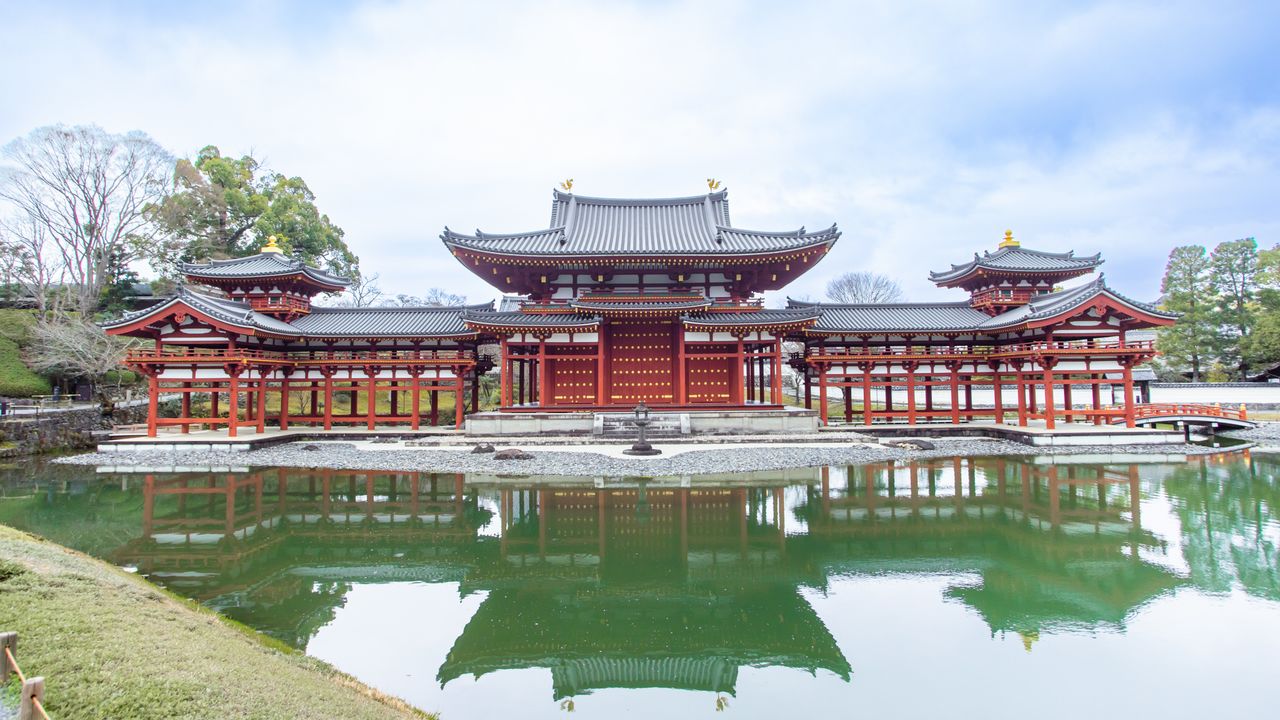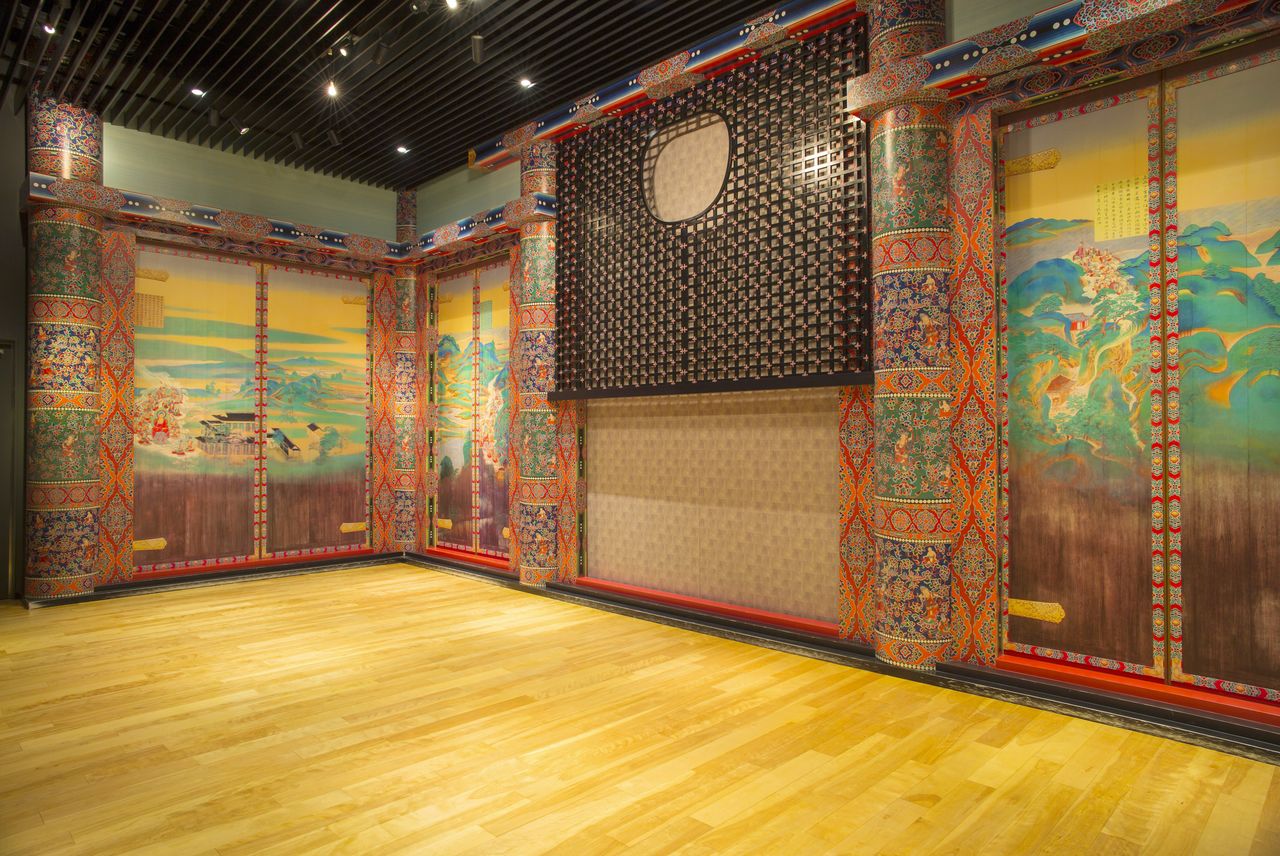
Byōdōin: World Heritage Buddhist Temple
Guideto Japan
Travel Culture History- English
- 日本語
- 简体字
- 繁體字
- Français
- Español
- العربية
- Русский
From Villa to Temple
Uji in the south of Kyoto Prefecture has been an important cultural center for centuries. In the Heian period (794–1185) it was the site of rural villas belonging to nobles, and it also features in The Tale of Genji, whose protagonists Prince Genji is purportedly modeled on the owner of one such villa, Minamoto no Tōru (822–895). Fujiwara no Michinaga (966–1028), a powerful regent at the imperial court, acquired Tōru’s villa, and in 1052, his son Yorimichi, chief advisor to the emperor, transformed the structure into a Buddhist temple. This was the beginnings of Byōdōin.
The year 1052 is significant as it is thought to mark the start of mappō, the “latter days of the Buddhist law.” Fearing for their salvation, the populace embraced the belief that followers of Amida Buddha would travel to the Buddhist Pure Land after death. Amidadō, temples dedicated to Amida Nyorai, were erected throughout Japan. The Amida Hall at Byōdōin was completed in 1053 and later named Hōōdō.

The Hōōdō at Byōdōin. The structure’s reflection on the mirror-like waters of Ajiike creates a mystical effect. (Courtesy of Byōdōin)
The Hōōdō, erected as the centerpiece of a Jōdo-style garden as a physical expression of the Pure Land, faces a placid pond, the Ajiike. The Pure Land is thought to lie to the west, and the building was designed for worship from afar from the east bank of the pond. A pair of phoenixes grace the roof, and the structure, when seen from the front, resembles a phoenix with outstretched wings. This association led the Amidadō to became known as Hōōdō, or Phoenix Hall, beginning in the Edo period (1603-1868).

The hall’s beauty has inspired the name “a palace floating on the Treasure Pond of the Pure Land.” (© Edit Plus)
The ¥10,000 note features the image of the phoenixes that stood guard over the Amidadō for 900 years. Those original figures were removed in 1968 for conservation purposes and replaced with replicas. In 2014, these were covered in gold leaf, restoring some of the original glimmer to the hall.

The mythical phoenix is considered sacred. The original figures that stood atop the Hōōdō are on display at the Hōshōkan, the Byōdōin’s museum on the temple grounds. (Courtesy of Byōdōin)
National Treasures Abound: Inside the Hōōdō
Not to be outdone by the exterior, Hōōdō’s interior is also a marvel to behold, housing what is said to be the greatest concentration of national treasures like Buddhist statues, paintings, and decorations in the country.
In the center of the building is a seated figure of Amida Nyorai created by Jōchō, a preeminent sculptor of the Heian period. The most striking characteristic of the sculpture is that the head and body were carved from separate pieces of wood and later joined together in a technique called yosegi, which Jōchō popularized. The statue stands 2.77 meters high but its overwhelming presence makes it appear much larger when viewed up close. The round mark on the figure’s forehead, called a byakugō, changes color and brightness depending on the angle at which it is viewed, lending it a mysterious air.

The statue of Amida Nyorai, its canopy, and the wall paintings are all national treasures. (Courtesy of Byōdōin)

This seated figure of Amida Nyorai is the only one of its kind that is certifiably Jōchō’s work. (Courtesy of Byōdōin)
In addition to the exquisite canopy above it, the Amida figure was originally surrounded by 52 relief sculptures of bodhisattvas, all designated national treasures, on the walls. Half of these are on display at the temple museum, and those that have been left in place are numbered according to their position north or south of the Amida figure. Depicted playing musical instruments or dancing, each is appealing in its own way.

The bodhisattvas displayed at the Hōshōkan. (Courtesy of Byōdōin)

From left: Bodhisattva No. 20 South is a dancing figure; Bodhisattva No. 21 South plays the shō, a wind instrument used in gagaku court music performances; and Bodhisattva No. 26 South is restored to its original appearance when it was created centuries ago. (Courtesy of Byōdōin)
The kuhon raikōzu painting covering the doors and walls inside the Hōōdō depicts Amida flanked by a host of bodhisattvas welcoming the deceased into the Pure Land. The scene shows the highest level of the nine ways in which a person will be met upon death, which is determined by an individual’s acts of merit and degree of faith while alive.

A restored section of the kuhon raikōzu. (Courtesy of Byōdōin)
Temple Bell and Minuscule Garden
Along with the Hōōdō, another must-see relic at Byōdōin is the temple’s bell, reputed to be one of the three finest in Japan. Along with the Miidera bell at Onjōji near Mount Hie, said to have the best sound, and the bell at Jingoji on the outskirts of Kyoto, famed for having the most refined inscription, Byōdōin’s bell is renowned for having the best appearance. The bell’s beautiful motifs, from phoenixes and lion-like shishi to representations of plants and flowers, are breathtaking in their artistry.

The bell currently in use is the temple’s second. On New Year’s Eve, visitors can take turns striking the bell as part of the joya no kane ritual in which the bell is rung 108 times to signify the number of worldly sins. (© Edit Plus)

The original temple bell is displayed at the museum. It measures 199 centimeters tall and 123 centimeters around and weighs about 2 tons. (Courtesy of Byōdōin)
A small, fan-shaped garden on the grounds is of historic significance as the site where late Heian period warrior Minamoto no Yorimasa (1106–1180) took his own life. In the war between the Taira and the Minamoto clans, which began with the Battle of Uji in 1180, the Minamoto were defeated. Yorimasa, spreading open his folding fan toward the west in the direction of the Pure Land, committed ritual suicide after reading a poem he had composed. Yorimasa’s grave is located behind the Hōōdō.

The grassy area where Minamoto no Yorimasa ended his life. (© Edit Plus)
Hōshōkan: Byōdōin’s Museum
The Byōdōin Museum Hōshōkan features a collection of precious artifacts, including the first pair of phoenixes topping the roof of the Hōōdō and the temple’s first bell, both national treasures. Objects are displayed under special lighting designed to highlight their exquisite workmanship.
One of the museum’s most dazzling exhibits reproduces the interior of the Hōōdō at the time of its construction, in full color with paintings depicting how the Heian nobility imagined the Pure Land. The adjacent museum shop offers a plentiful array of goods and souvenirs featuring Byōdōin-related motifs.

To blend in with the garden, the museum was constructed largely underground. (© Edit Plus)

An exhibit reproducing Hōōdō’s splendid wall paintings. (Courtesy of Byōdōin)

From left: Origami paper with motifs based on Hōōdō ornamentation, decorative masking tape, and a bookmark with a cutout illustration of the Hōōdō. (Courtesy of Byōdōin)
Opposite the museum is Teahouse Tōka, which serves local Uji tea brewed from specially selected tea leaves. Take a break from exploring Byōdōin to enjoy green tea in an authentically modern Japanese setting.

Teahouse Tōka serves authentic Uji green tea. (© Edit Plus)

Chilled Uji gyokuro green tea, served with specially made Japanese sweets. (Courtesy of Byōdōin)
Byōdōin
- Address: 116 Ujirenge, Uji, Kyoto Prefecture
- Hours: 8:30 am to 5:30 pm (last entry 5:15 pm)
Byōdōin Museum Hōshōkan: 9:00 am to 5:00 pm (last entry 4:45 pm) Teahouse Tōka: 10:00 am to 4:30 pm (last order 4:00 pm); closed Mondays, Tuesdays, and Wednesdays (open if those days fall on a public holiday) - Entrance fee: ¥600 (includes entry to the Hōshōkan); an additional ¥300 is required to view inside the Hōōdō, with a time slot for viewing assigned on purchase of a ticket; limited to 50 persons per time slot, on a first-come, first-served basis
- Getting there: 10 minutes’ walk from JR and Keihan Uji Stations.
(Originally published in Japanese. Reporting, text, and photos by Edit Plus unless otherwise noted.)
